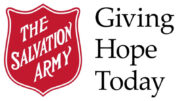The frequency and impact of natural disasters is on the rise worldwide. Earthquakes, hurricanes, tsunamis, forest fires, tornadoes, ice storms and severe rain storms are happening more often than ever before.
As one of Canada’s major emergency relief organizations, The Salvation Army is, many a time, assigned specific roles by Emergency Preparedness authorities. Emotional and spiritual support, registration and inquiry, shelter, transportation, emergency housing, feeding or clothing is provided both in the response and recovery phase.
The Salvation Army has developed a National Disaster Training Program (NDTP), a very detailed emergency response training program whereby volunteers are trained in every aspect of The Salvation Army emergency response. Only pre-trained, pre-registered volunteers are called on during an emergency or disaster response.
The Army’s established and well-rehearsed emergency protocol allows the organization to deliver fast, efficient service to first responders and disaster survivors. And while the Army is often first at the scene, it is the last to leave when tragedy strikes.
The Salvation Army in Grande Prairie is ready to respond to any disaster that strikes our community. From forest fires to floods, to house fires. Our Community Response van is here to help!
Emergency Disaster Services Team from Grande Prairie Deployed to Fort Vermilion
The Salvation Army’s Emergency Disaster Services (EDS) teams were deployed to Fort Vermilion on May 3, after a flood left 750 residents displaced in the middle of a global pandemic.
The unique situation of this disaster has been dealing with added safety measures and precautions caused by COVID-19 but when disaster strikes, The Salvation Army is there to serve. For this mission, as there is no Salvation Army in Fort Vermillion, the EDS team from Grand Prairie was deployed with their Community Response Unit (CRU) and they have been serving meals to returning residents, volunteers, first responders, and other organizations helping with clean-up and rebuilding.
“It’s not just a canteen or food truck that comes in to feed and is transaction based, this is relationship based and people are so grateful,” Grande Prairie Salvation Army Community Ministries Officer, Captain Peter Kim said. “We’ve even had evacuees bring Tim Hortons, which is 40 minutes away, to support us as volunteers.”
A typical day on the canteen consists of two cooks, two volunteers handling meal distribution, and one volunteer tasked with clean-up. They have been providing breakfast, lunch, and dinner, seven days a week for about 370 people a day. Many of those may be due to the boil water advisory in place for residents, leaving some unable to use their kitchen.
“Many were in need of food,” said Kim. “We’re able to take care of that so they can focus on taking care of their home and rebuild.”
Many have lost their homes and others have seen about four to seven feet of water causing major damage. The emotional state of residents returning was low but as the week went on, The Salvation Army volunteer team began to see smiles on their faces.
“We continue to be there to support them and they begin to open up and share a lot more of their experiences and lives with us,” said Kim. “Its not just about food, its about loving them and building relationships.”
Volunteers have come from surrounding areas such as Grand Prairie, High Level, and La Crete to help serve residents returning home. They understand what Fort Vermillion residents are going through as many had been affected and displaced during previous disaster incidents.
The Salvation Army Grand Prairie will continue to provide food services and emotional and spiritual care in Fort Vermilion as long as they are needed.
